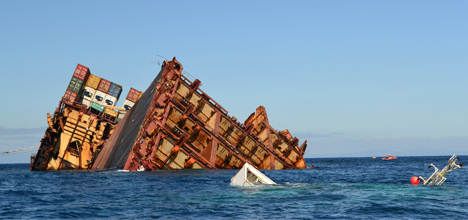Svitzer salvors say the seafloor in the vicinity of the Rena wreck is a container ‘graveyard'.
Maritime New Zealand salvage operations manager Dave Billingham says many of the containers lost during the January 7-8 storm remain unaccounted for.
Rena lies broken on the Astrolabe Reef above tonnes of twisted, broken steel – a container graveyard. Photo: LOC.
It was originally estimated 200-300 containers went into the sea when the ship broke up during this storm; a number later reduced to about 150.
Only a comparatively few have washed up on Bay of Plenty beaches since then and sonar scans of the seafloor in the wreck's vicinity have failed to find any intact containers.
'The divers are saying it is what they call a graveyard of damaged containers,” says David.
'They have been torn in pieces and it's very difficult to assess the numbers of containers that are present.”
Salvors are concentrating on removing the containers from the bow section that remains above water.
It's thought 283 remain below deck in the forward section and they are contributing to the deterioration of the structure.
The bottom was torn out of the ship when it struck the reef at 17 knots on October 5, allowing the action of tide and sea to bounce the containers up against the underside of the deck hatches.
The lifted hatches and tilted container stacks are the result of the power of that action – named hydraulicking.
The smaller hatches weigh 35 tonnes, the bigger ones 45-50 tonnes.
'Imagine the forces acting inside the ship that are causing that,” says David.
In addition to the internal battering, the bow section is also subject to wind and tide, and will become more prone to movement as the deck cargo is removed.
The sensors onboard the bow section are recording increasing movement, which can also be seen by the salvors working on the wreck.
A large remote operated vehicle has been ordered by the salvage team investigating the sunken stern main section of the Rena.
The stern is lying in 70 metres of water on a reef with the surrounding sea floor at 80-85 metres. Removing the wreckage is presenting challenges.
There is no knowledge what will happen when salvors begin sectioning the wreck for removal, whether the action of cutting it up will send it sliding way down the reef.
Breamar Howells managing director Simon Rickaby says the way the Bay of Plenty community has pulled together as a result of the Rena disaster is 'superb”.

Braemar Howells managing director Simon Rickaby.
A small population has set aside differences to work on a common problem.
'The good news is it wasn't a large container ship,” says Simon.
'There are 16,000 TEU ships out there – if it had been one of those you would have been deep in the brown stuff.”
The Rena remains a challenge and the answer to meeting it is the same as the advice for eating an elephant – one bite at a time, says Simon.



2 comments
dont worry.....
Posted on 03-02-2012 10:33 | By claypole
with the imminent dredging of the port, those bigger ships will arrive. Then we will be in the National! Money over the environment, yes please!
dollie
Posted on 12-02-2012 09:09 | By Dollie
When you track it back,it is the port and the councils who let ships like the Rena come in to Tauranga that are responsible for what happened on Astrolabe. Dredging will definitely cause bigger and more ships to come in.
Leave a Comment
You must be logged in to make a comment.